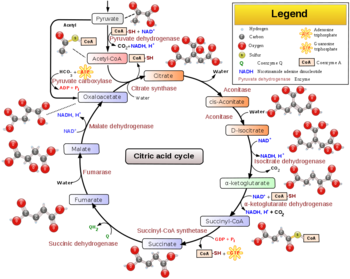Citric Acid Cycle
From Proteopedia
The Citric Acid Cycle is a key metabolic pathway that connects carbohydrate, fat, and protein metabolism!!! See also [1].
The Citric Acid Cycle (tricarboxylic acid cycle) is a series of enzyme catalyzed reactions which are critical in cellular respiration. Under oxidative conditions, pyruvate continues to be metabolized through the tricarboxylic acid cycle. In this cycle, Acetyl-CoA, a byproduct of glycolysis, along with various cofactors, are broken down into carbon dioxide, water, and energy in the form of GTP and NADH. Pyruvate decarboxylation or pyruvate oxidation, also known as the link reaction (or oxidative decarboxylation of pyruvate), is the conversion of into by the enzyme complex pyruvate dehydrogenase complex (see Pyruvate dehydrogenase). The multienzyme complex together catalyzes five distinct reactions in the conversion of pyruvate to Acetyl-CoA. The overall result is described by the following reaction: Pyruvate + CoA + NAD+ ==> Acetyl-CoA + CO2 + NADH However, pyruvate dehydrogenase (E1) is responsible for only the first two of the five reactions. The first of these is the decarboxylation of pyruvate and coupling of thiamine pyrophosphate (TPP) to form hydroxyethyl-TPP. Pyruvate + TPP ==> Hydroxyethyl-TPP + CO2 Step 0 / 10 - Aldol condensation - Citrate synthase
4C to a 6C molecule Step 1 - Dehydration - Aconitase
6C Citrate => 6C Step 2 - Hydration - Aconitase
6C cis-Aconitate => 6C Step 3 - Oxidation - Isocitrate dehydrogenase
6C Isocitrate => 6C Step 4 - Decarboxylation - Isocitrate dehydrogenase
6C Oxalosuccinate => 5C The α-ketoglutarate family of amino acid synthesis (synthesis of glutamate, glutamine, proline and arginine) begins with α-ketoglutarate, an intermediate in the Citric Acid Cycle. See Alpha-Ketoglutarates: glutamate, glutamine, proline, arginine Step 5 - Oxidative decarboxylation - α-Ketoglutarate dehydrogenase (2-Oxoglutarate Dehydrogenase) 5C α-Ketoglutarate => 4C chain (CoA excluded) Step 6 - Substrate-level phosphorylation - Succinyl-CoA synthetase Succinyl-CoA => The succinyl-CoA formed during Beta oxidation can also enter the Citric Acid Cycle in this step. Step 7 - Oxidation - Succinate dehydrogenase Succinate => Step 8 - Hydration - Fumarase
Fumarate => Step 9 - Oxidation - Malate dehydrogenase
L-Malate => Oxaloacetate takes part in gluconeogenesis, the urea cycle, the glyoxylate cycle, amino acid synthesis (Oxaloacetate/aspartate: lysine, asparagine, methionine, threonine, and isoleucine), fatty acid synthesis. Step 10 / 0 - Aldol condensation - Citrate synthase
4C to a 6C molecule To view automatically seeded indices concerning Citric Acid Cycle See:
See also:
| |||||||||||
Proteopedia Page Contributors and Editors (what is this?)
Alexander Berchansky, David Canner, Ann Taylor, Wayne Decatur, Jaime Prilusky

